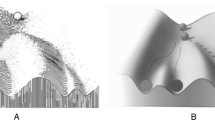Abstract
Biologists and philosophers often use the language of determination in order to describe the nature of developmental phenomena. Accounts in terms of determination have often been reductionist. One common idea is that DNA is supposed to play a special explanatory role in developmental explanations, namely, that DNA is a developmental determinant. In this article we try to make sense of determination claims in developmental biology. Adopting a manipulationist approach, we shall first argue that the notion of developmental determinant is causal. We suggest that two different theses concerning developmental determination can be articulated: determination of occurrence and structural determination. We shall argue that, while the first thesis is problematic, the second, opportunely qualified, is feasible. Finally, we shall argue that an analysis of biological causation in terms of determination cannot account for entangled dynamics. Characterising causal entanglement as a particular kind of interactive causation whereby difference-making causes ascribable to different levels of biological organisation influence a particular ontogenetic outcome, we shall, via two illustrative examples, diagnose some potential limits of a reductionist, molecular and intra-level understanding of biological causation.







Similar content being viewed by others
Notes
We prefer the expression “phenotypic outcome” to “gene product” because the latter betrays a DNA-centric causal bias.
Here the point is simply that synchronic constitutive analysis accounts for the difference in spatial organisation of the two biosystems independently of the nature of the relationship between its constituent entities. This is sufficient to vindicate a principled constitution-causality distinction. At the same time, the direction of the arrow implies causation and a relationship of diachronic ‘influencing’ between the entities. It is for this reason that constitutive analysis is intrinsically limited when dealing with biological processes.
Halder et al.’s (1995) genetic experiments with Drosophila in which the expression of gene Ey is argued to be “necessary and sufficient to induce ectopic eyes” (Halder et al. 1995, p. 1791) even in wings and antennae seems to contravene our argument. However, note that the claim that Ey determines eye morphogenesis should be qualified. First of all, this gene is not the only one regulating this morphogenetic process because “…we estimate that more than 2500 genes are involved in eye morphogenesis” (Halder et al. 1995, p. 1791). Nonetheless, some interesting determination claims remain compatible with the evidence, namely that either Ey causes one or a series of switch points or even that the entire developmental trajectory is entirely regulated by genomic resources (i.e., that all its switch-points are caused by genomic inputs, e.g. Ey and thousands of other genes). This latter hypothesis is a form of genetic determinism because an adult phenotype would be fully determined by genomic inputs. At the end of this section we show that even such hypotheses are suspicious.
This applies to the Ey case as well (see note 3). Gene expression processes do not happen in a vacuum but in a developmental context that is rich in extra-genomic developmental resources such as molecular agents and environmental inputs. To emphasise Ey’s and the 2.500 other genes’s causal contribution to the process of eye morphogenesis in Drosophila is to dismiss as causally irrelevant these extra-genomic resources of the developmental context.
The concept of determination of occurrence seen in Sect. 4 (i.e., that a developmental factor is a necessary and sufficient condition for the occurrence of a specific developmental outcome at a specific switch point) and the concept of structural determination (i.e., that a developmental factor is a highly specific cause that fully accounts for the structural features of a developmental outcome) to be articulated in this section are different. The reason is that a difference-making cause could be a structural determinant without being an occurrence determinant.
It should be added that these naturally produced molecular conformations should not be caused by DNA differences. For instance, they might be phenotypic mutations (Bürger et al. 2006).
Evolutionary studies concerning the nature of extant bacterial polymerases might indeed substantiate this argument if natural “manipulations” were discovered. We thank Staffan Müller–Wille for this suggestion.
It should be noted that Noble himself speaks explicitly of downward causation (2006).
It should also be noted that Lesne and Victor (2006) indifferently use expressions like “emergent property”, “regulation” and “constraint”. Whether the notion of constraint used by Lesne and Victor bears a close relationship with that articulated by Umerez and Mossio (2013) is beyond the scope of the paper.
References
Baravalle L, Vecchi D (2016) Beyond blindness: on the role of organism and environment in trial generation. Stud Hist Philos Sci Part C Stud Hist Philos Biolog Biomed Sci 60:25–34
Baumgartner M (2009) Interventionist causal exclusion and non-reductive physicalism. Int Stud Philos Sci 23(2):161–178
Bechtel W (2015) Can mechanistic explanation be reconciled with scale-free constitution and dynamics? Stud Hist Philos Biolog Biomed Sci 2015(53):84–93
Bürger R et al (2006) Why are phenotypic mutation rates much higher than genotypic mutation rates? Genetics 172:197–206
Clancy S (2008) RNA transcription by RNA polymerase: prokaryotes vs eukaryotes. Nat Educ 1(1):125
Craver C, Bechtel B (2006) Mechanism. In: Sarkar S, Pfeifer J (eds) The philosophy of science: an encyclopedia. Routledge, New York, pp 469–478
Craver CF, Bechtel W (2007) Top-down causation without top-down causes. Biol Philos 20:715–734
Crews D (2003) Sex determination: where environment and genetics meet. Evolut Dev 5(1):50e55
Crick F (1958) On protein synthesis. Symp Soc Exp Biol 12:138–163
Davis MC (2017) The essential activities of the bacterial sigma factor. Can J Microbiol 63:89–99
Delbrück M (1971) Aristotle-totle-totle. In: Monod J, Borek E (eds) Of microbes and life. Columbia University Press, New York, pp 50–55
Dhouailly D (1983) Early events in retinoic acid-induced ptilopody in the chick embryo. Wilehm Roux Arch Dev Biol 192(1):21–27
Eronen MI (2013) No levels, no problems: downward causation in neuroscience. Philos Sci 80(5):1042–1052
Gilbert S (2000) Developmental biology. Sinauer Associates, Sunderland
Gilbert S, Sarkar S (2000) Embracing complexity: organicism for the 21st century. Dev Dyn 219:1–9
Griffiths P, Stotz K (2013) Genetics and philosophy: an introduction. Cambridge University Press, Cambridge
Griffiths P et al (2015) Measuring causal specificity. Philos Sci 82(4):529–555
Halder G, Callaerts P, Gehring WJ (1995) Induction of ectopic eyes by targeted expression of the eyeless gene in Drosophila. Science 267(5205):1788–1792
Hartl FU et al (2011) Molecular chaperones in protein folding and proteostasis. Nature 475:324–332
Hennig W (1966) Phylogenetic systematics. University of Illinois Press, Urbana, p 65
Kirschner M, Gerhart JC (2005) The plausibility of life. Yale University Press, New Haven
Laubichler M, Wagner GP (2001) How molecular is molecular developmental biology? A reply to Alex Rosenberg’s reductionism redux: computing the embryo. Biol Philos 16:53–68
Lesne A (2013) Multiscale analysis of biological systems. Acta Biotheor 61(1):3–19
Lesne A, Victor JM (2006) Chromatin fiber functional organisation: some plausible models. Eur Phys J E 19:279–290
Levin M (2012) Morphogenetic fields in embryogenesis, regeneration, and cancer: non-local control of complex patterning. BioSystems 109:243–261
Lewontin R, Levins R (2007) Biology under the influence: dialectical essays on the coevolution of nature and society. Monthly Review Press, New York City
Maffini MV, Calabro JM, Soto AM, Sonnenschein C (2005) Stromal regulation of neoplastic development: age-dependent normalization of neoplastic mammary cells by mammary stroma. Am J Pathol 67:1405–1410
Mahner M, Bunge M (1997) Foundations of biophilosophy. Springer, Berlin
Malaterre C (2011) Making sense of downward causation in manipulationism. Hist Philos Life Sci 33:537–562
Malyshev DA et al (2014) A semi-synthetic organism with an expanded genetic alphabet. Nature 509:385–388
Noble D (2006) The music of life biology beyond the genome. Oxford University Press, Oxford
Noble D (2008) Genes and causation. Philos Trans R Soc A 366:3001–3015
Noble D (2012) A theory of biological relativity: no privileged level of causation. Interface Focus 2(1):55–64
Noble D, Noble SJ (1984) A model of S.A. node electrical activity using a modification of the Di Francesco-Noble equations. Proc R Soc B 222:295–304
Noss RF (1990) Indicators for monitoring biodiversity: a hierarchical approach. Conserv Biol 4(4):1990
Pierce BA (2012) Genetics: a conceptual approach. W.H. Freeman & Co., New York
Raatikainen P (2010) Causation, exclusion, and the special sciences. Erkenntnis 3:349–363
Rosenberg A (1997) Reductionism redux: computing the embryo. Biol Philos 12:445–470
Sarkar S (2005) Molecular models of life. MIT Press, Cambridge
Shapiro L, Sober E (2007) Epiphenomenalism. The do’s and don’ts. In: Wolters G, Machamer P (eds) Thinking about causes: from greek philosophy to modern physics. University of Pittsburgh Press, Pittsburgh, pp 235–264
Umerez J, Mossio M (2013) Constraint. In: Dubitzky W, Wolkenhauer O, Yokota H, Cho K-H (eds) Encyclopedia of systems biology. Springer, New York, pp 490–493
Vecchi D, Hernandez I (2014) The epistemological resilience of the concept of morphogenetic field. In: Minelli A, Pradeu T (eds) Towards a theory of development. Oxford University Press, Oxford, pp 79–94
Waddington CH (1939) Genes as evocators in development. Growth 1:S37–S44
Waters K (2007) Causes that make a difference. J Philos 104(11):551–579
Weber M (2006) The central dogma as a thesis of causal specificity. Hist Philos Life Sci 28:595–610
West-Eberhard MJ (2003) Developmental plasticity and evolution. Oxford University Press, Oxford
Wolpert L (1991) The triumph of the embryo. Oxford University Press, Oxford
Woodward J (2003) Making things happen. Oxford University Press, Oxford
Woodward J (2008) Mental causation and neural mechanisms. In: Hohwy J, Kallestrup J (eds) Being reduced: new essays on reductive explanation and special science causation. Oxford University Press, Oxford, pp 218–262
Woodward J (2010) Causation in biology: stability, specificity, and the choice of levels of explanation. Biol Philos 25:287–318
Ylikoski P (2014) Rethinking micro–macro relations. In: Zahle J, Collin F (eds) Rethinking the individualism-holism debate. Springer International Publishing, Basel
Zuckerkandl E, Villet R (1988) Concentration-affinity equivalence in gene regulation: convergence of genetic and environmental effects. Proc Natl Acad Sci USA 85:4784–4788
Acknowledgements
D.V. acknowledges the financial support of the Fundação para a Ciência e a Tecnologia (FCT Grant No. SFRH/BPD/99879/2014, BIODECON R&D Project. Grant PTDC/IVC-HFC/1817/2014) and of the Fondo Nacional de Desarrollo Científico y Tecnológico de Chile (Grant No. 1171017 FONDECYT REGULAR). We thank Lorenzo Baravalle, Maurizio Esposito, Gil Santos and the reviewers for feedback.
Author information
Authors and Affiliations
Corresponding author
Rights and permissions
About this article
Cite this article
Vecchi, D., Miquel, PA. & Hernández, I. From Biological Determination to Entangled Causation. Acta Biotheor 67, 19–46 (2019). https://doi.org/10.1007/s10441-018-9339-6
Received:
Accepted:
Published:
Issue Date:
DOI: https://doi.org/10.1007/s10441-018-9339-6




